new posts in all blogs
Viewing: Blog Posts Tagged with: 2016 funny books, Most Recent at Top [Help]
Results 1 - 4 of 4
How to use this Page
You are viewing the most recent posts tagged with the words: 2016 funny books in the JacketFlap blog reader. What is a tag? Think of a tag as a keyword or category label. Tags can both help you find posts on JacketFlap.com as well as provide an easy way for you to "remember" and classify posts for later recall. Try adding a tag yourself by clicking "Add a tag" below a post's header. Scroll down through the list of Recent Posts in the left column and click on a post title that sounds interesting. You can view all posts from a specific blog by clicking the Blog name in the right column, or you can click a 'More Posts from this Blog' link in any individual post.
 Every single list that appears on this blog is subjective. I mean, here I am declaring stuff to be great based entirely on a single solitary opinion: my own. That’s okay when you’re talking alphabet books or readalouds, but humor is a far trickier matter. There are a LOT of humorous picture books that come out in a single year and this list is just a miniscule smattering of the whole. That said, these are the books that really retained a strong grip on my brain after reading them. There were other funny books out in 2016. I’m just particularly partial to the following. I’m pleased with the number of funny women representing here too. After all, if there’s one thing I know something about, it’s funny girls.
Every single list that appears on this blog is subjective. I mean, here I am declaring stuff to be great based entirely on a single solitary opinion: my own. That’s okay when you’re talking alphabet books or readalouds, but humor is a far trickier matter. There are a LOT of humorous picture books that come out in a single year and this list is just a miniscule smattering of the whole. That said, these are the books that really retained a strong grip on my brain after reading them. There were other funny books out in 2016. I’m just particularly partial to the following. I’m pleased with the number of funny women representing here too. After all, if there’s one thing I know something about, it’s funny girls.
2016 Funny Picture Books
Best Frints in the Whole Universe by Antoinette Portis
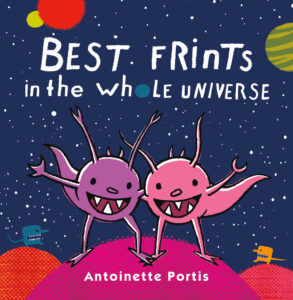
Kind of like Du Iz Tak? but with a slight increase in English, this alien friendship story earns its humor stripes when it explains those little socially awkward moments like when you accidentally/on purpose bite off your best frint’s tail.
Dylan the Villain by K.G. Campbell
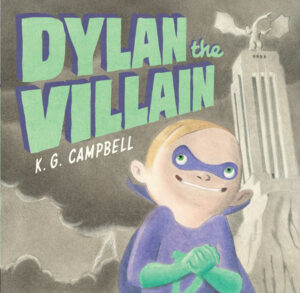
First off, I love that in this world, villainy is genetic but is capable of skipping generations. Second, I love that our anti-hero’s antagonist is a girl with a killer purple eyepatch. Having super villains as heroes isn’t a new idea in the movies, but in picture books it doesn’t happen all that often. I, for one, am hoping for more Dylan in the future.
The Happiest Book Ever! by Bob Shea

Every book should have a frog in it. There’s a lot of happy happy joy joy to this book mixed with a tincture of Monty Python. Could you ask for anything more?
A Hungry Lion by Lucy Ruth Cummins
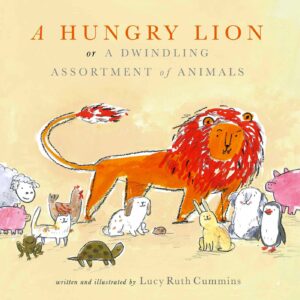
The subtitle, which is distinctly Edward Gorey-esque, gives you an indication of what kind of funny book this is. You know what it reminds me of? The movie Alien. And, naturally, the turtle is Ripley. Oh, like you hadn’t considered it before.
I Don’t Want To Be Big by Dev Petty, ill. Mike Boldt
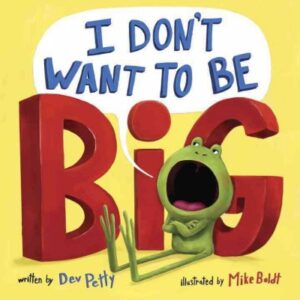
I didn’t bother to do this with any of the other books on this list, but for this one, I wanted to show you my favorite gag. The idea is that the frog is arguing that growing up is a bum rap. His dad tries to come up with reasons why it should still be done. So we get this:
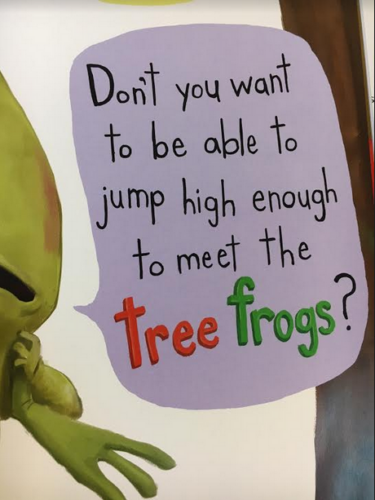
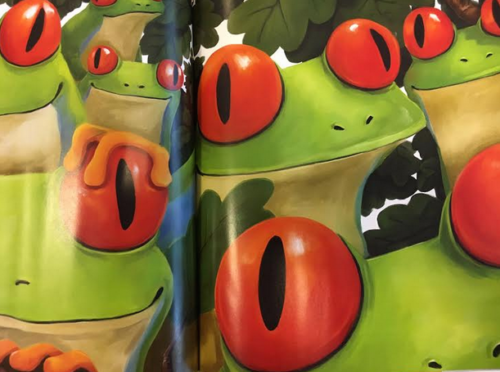
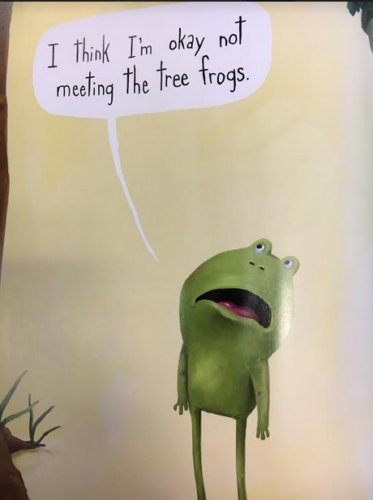
The defense rests, your honor.
Is That Wise Pig? by Jan Thomas
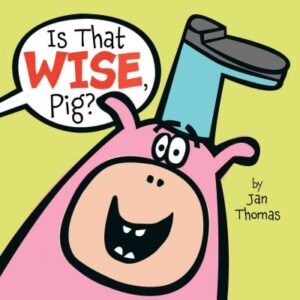
I mean, there’s a boot on that pig’s head. A boot! Just sayin’.
King Baby by Kate Beaton
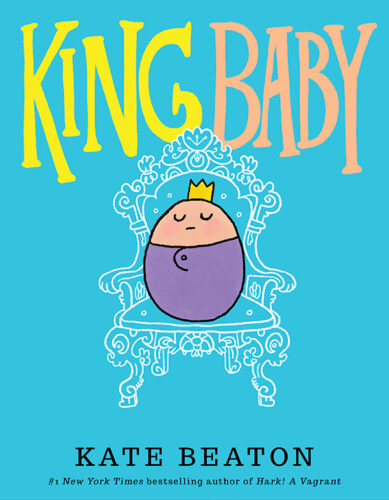
We’re getting there. Beaton’s starting out slow with her picture books. This one’s funnier than her last, and at the rate she’s going she should be able to make a perfectly Beaton-esque one soon. Though, to be frank, this next book on my list felt like Kate Beaton but not by Kate Beaton:
Leave Me Alone! by Vera Brosgol
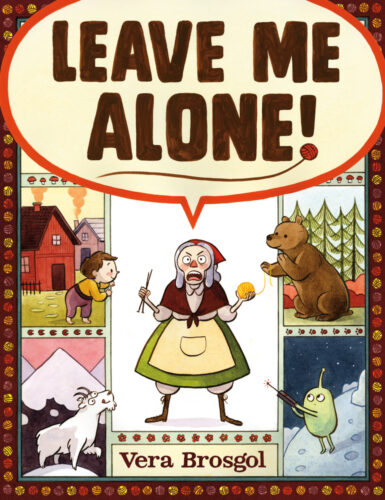
Did you notice that it appeared on the NPR Book Concierge for 2016? Did you notice who blurbed it? Ah, thank you. Ah, thank you.
Monsters Go Night-Night by Aaron Zenz
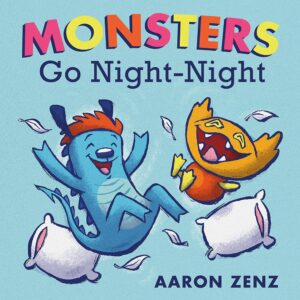
Proving yet again that I have the sense of humor of a 5-year-old. But let’s be frank. That potty joke? The best misdirection I’ve seen on a page in a long time.
Next to You: A Book of Adorableness by Lori Haskins Houran, ill. Sydney Hanson
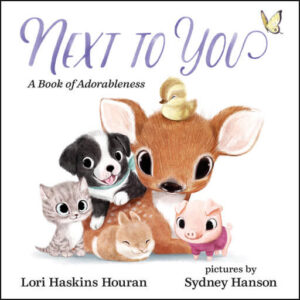
I’m going to stand by this one as a humor book. It throws you off with its big-eyed animals and then you get the snarky text. Seriously funny.
Oh No, Astro! by Matt Roeser, ill. Brad Woodard
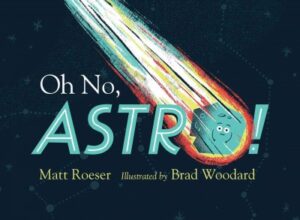
Proof positive that you can be a funny book and a visually stunning one all at the same time.
Penguin Problems by Jory John, ill. Lane Smith
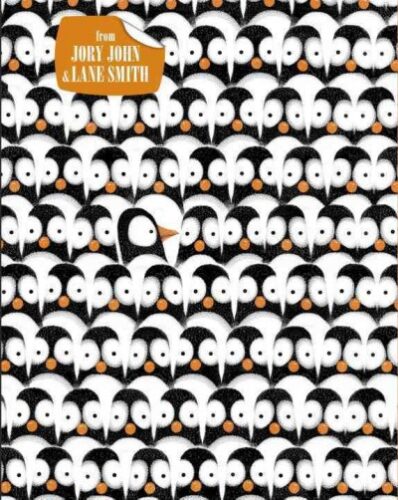
Misanthropic penguins make for comedy gold. Every good author worth his or her salt knows that.
Poor Little Guy by Elanna Allen
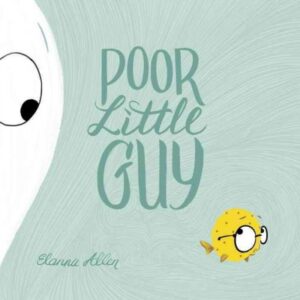
Of all the books on my list today, I worry that this one is the most underrated. Did you ever get a chance to read it? I feel like it got buried under a lot of other publications, but for sheer visual storytelling and gags it’s an out-and-out winner. I. Just. Love. It. Love it, love it, love it.
President Squid by Aaron Reynolds, ill. Sara Varon
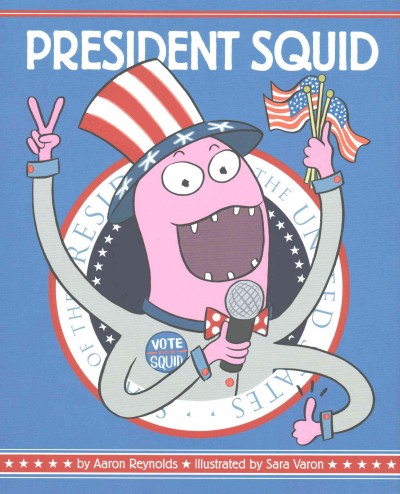
Okay. Your mission, should you choose to accept it, is to watch this video at the 18:30 mark. That’s when Aaron reads from his book and it’s the funniest reading ever you did see.
Pug Man’s 3 Wishes by Sebastian Meschenmoser
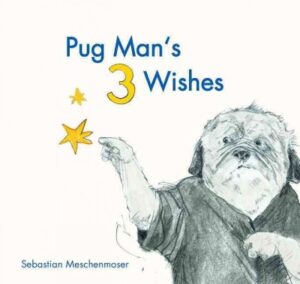
He’s the funniest German picture book author/illustrator of all time. Granted, the competition may not be particularly intense . . .
Quit Calling Me a Monster! by Jory John, ill. Bob Shea
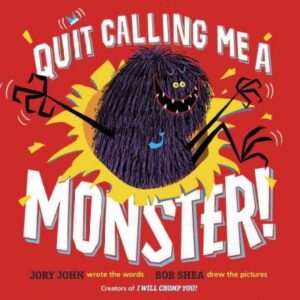
Both Jory and Bob are on this list twice. And I’d take off one of their books apiece, honest I would, if it weren’t for the fact that the monster in this book is named Floyd Patterson. I mean, I’m only human, after all.
Super Happy Magic Forest by Matty Long
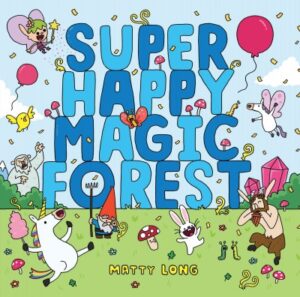
2016 was a good year for picture books making fun of fantasy tropes. I honestly think this book would appeal to any kid, though, regardless of their interest in swords and sorcery. Plus there’s a Gollum reference on one of the pages, so kudos there.
This is My Book by Mark Pett (and no one else)
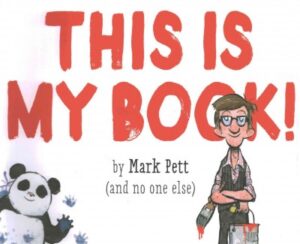
I almost swallowed my gum when I saw that the author of this book was Mark Pett. Pett? A subdued author/illustrator by and large, this book is a huge departure for him. A huge, hilarious departure. We could all use a mischievous panda in our lives.
A Voyage in the Clouds: The (Mostly) True Story of the First International Flight by Balloon in 1785 by Matthew Olshan, ill. Sophie Blackall
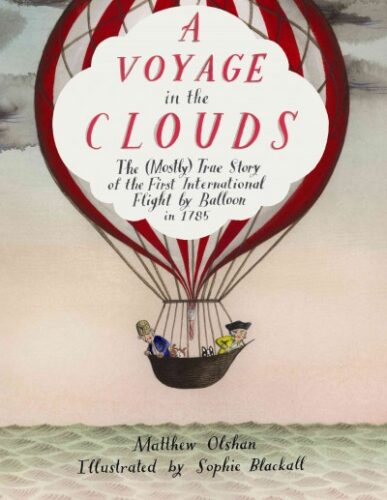
Somehow the fact that it’s all based on a true story (the iron vest, the peeing off the boat, the landing in their underwear, etc.) makes it all the funnier. Plus the fact that Ms. Sophie Blackall is in Funny Girl in 2017 is just the icing on the cake.
Who What Where? by Olivier Tallec
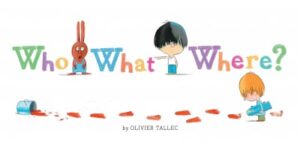
It’s a sequel but I don’t rightly care. It’s a hilarious sequel and may even improve upon the original.
Interested in the other upcoming lists of this month? Here’s the schedule so that you can keep checking back:
December 1 – Board Books
December 2 – Board Book Adaptations
December 3 – Nursery Rhymes
December 4 – Picture Book Readalouds
December 5 – Rhyming Picture Books
December 6 – Alphabet Books
December 7 – Funny Picture Books
December 8 – Calde-Nots
December 9 – Picture Book Reprints
December 10 – Math Picture Books
December 11 – Bilingual Books
December 12 – International Imports
December 13 – Books with a Message
December 14 – Fabulous Photography
December 15 – Fairy Tales / Folktales
December 16 – Oddest Books of the Year
December 17 – Older Picture Books
December 18 – Easy Books
December 19 – Early Chapter Books
December 20 – Graphic Novels
December 21 – Poetry
December 22 – Fictionalized Nonfiction
December 23 – American History
December 24 – Science & Nature Books
December 25 – Transcendent Holiday Titles
December 26 – Unique Biographies
December 27 – Nonfiction Picture Books
December 28 – Nonfiction Chapter Books
December 29 – Novel Reprints
December 30 – Novels
December 31 – Picture Books


By:
Betsy Bird,
on 9/4/2016
Blog:
A Fuse #8 Production
(
Login to Add to MyJacketFlap)
JacketFlap tags:
Reviews,
historical fiction,
Louise Erdrich,
funny books,
Harper Collins,
Best Books,
middle grade historical fiction,
Best Books of 2016,
2016 reviews,
Reviews 2016,
2016 middle grade historical fiction,
2016 funny books,
Add a tag
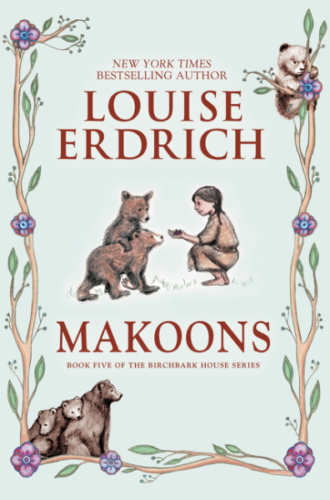 Makoons
Makoons
By Louise Erdrich
Harper Collins
$16.99
ISBN: 9780060577933
Ages 7-12
On shelves now
They say these days you can’t sell a novel for kids anymore without the book having some kind of “sequel potential”. That’s not really true, but there are a heck of a lot of series titles out there for the 7 to 12-year-old set, that’s for sure. New series books for children are by their very definition sort of odd for kids, though. If you’re an adult and you discover a new series, waiting a year or two for the next book to come out is a drop in the bucket. Years fly by for grown-ups. The wait may be mildly painful but it’s not going to crush you. But series for kids? That’s another matter entirely. Two years go by and the child has suddenly become an entirely different person. They may have switched their loyalties from realistic historical fiction to fantasy or science fiction or (heaven help us) romance even! It almost makes more sense just to hand them series that have already completed their runs, so that they can speed through them without breaking the spell. Almost makes more sense . . . but not quite. Not so long as there are series like “The Birchbark House Series” by Louise Erdrich. It is quite possibly the only historical fiction series currently underway for kids that has lasted as long as seventeen years and showing no sign of slowing down until it reaches its conclusion four books from now, Erdrich proves time and time again that she’s capable of ensnaring new readers and engaging older ones without relying on magic, mysteries, or post-apocalyptic mayhem. And if she manages to grind under her heel a couple stereotypes about what a book about American Indians in the past is “supposed” to be (boring/serious/depressing) so much the better.
Chickadee is back, and not a second too soon. Had he been returned to his twin brother from his kidnapping any later, it’s possible that Makoons would have died of the fever that has taken hold of his body. As it is, Chickadee nurses his brother back to health, but not before Makoons acquires terrifying visions of what is to come. Still, there’s no time to dwell on that. The buffalo are on the move and his family and tribe are dedicated to sustaining themselves for the winter ahead. There are surprises along the way as well. A boasting braggart by the name of Gichi Noodin has joined the hunt, and his posturing and preening are as amusing to watch as his mistakes are vast. The tough as nails Two Strike has acquired a baby lamb and for reasons of her own is intent on raising it. And the twin brothers adopt a baby buffalo of their own, though they must protect it against continual harm. All the while the world is changing for Makoons and his family. Soon the buffalo will leave, more settlers will displace them, and three members of the family will leave, never to return. Fortunately, family sustains, and while the future may be bleak, the present has a lot of laughter and satisfaction waiting at the end of the day.
While I have read every single book in this series since it began (and I don’t tend to follow any other series out there, except possibly Lockwood & Co.) I don’t reread previous books when a new one comes out. I don’t have to. Neither, I would argue, would your kids. Each entry in this series stands on its own two feet. Erdrich doesn’t spend inordinate amounts of time catching the reader up, but you still understand what’s going on. And you just love these characters. The books are about family, but with Makoons I really felt the storyline was more about making your own family than the family you’re born into. At the beginning of this book Makoons offers the dire prediction that he and his brother will be able to save their family members, but not all of them. Yet by the story’s end, no matter what’s happened, the family has technically only decreased by two people, because of the addition of another.
Erdrich has never been afraid of filling her books with a goodly smattering of death, dismemberment, and blood. I say that, but these do not feel like bloody books in the least. They have a gentleness about them that is remarkable. Because we are dealing with a tribe of American Indians (Ojibwe, specifically) in 1866, you expect this book to be like all the other ones out there. Is there a way to tell this story without lingering on the harm caused by the American government to Makoons, his brother, and his people? Makoons and his family always seem to be outrunning the worst of the American government’s forces, but they can’t run forever. Still, I think it’s important that the books concentrate far more on their daily lives and loves and sorrows, only mentioning the bloodthirsty white settlers on occasion and when appropriate. It’s almost as if the reader is being treated in the same way as Makoons and his brother. We’re getting some of the picture but we’re being spared its full bloody horror. That is not to say that this is a whitewashed narrative. It isn’t at all. But it’s nice that every book about American Indians of the past isn’t exactly the same. They’re allowed to be silly and to have jokes and fun moments too.
That humor begs a question of course. Question: When is it okay to laugh at a character in a middle grade novel these days? It’s not a simple question. With a high concentration on books that promote kindness rather than bullying, laughing at any character, even a bad guy, is a tricky proposition. And that goes double if the person you’re laughing at is technically on your side. Thank goodness for self-delusion. As long as a character refuses to be honest with him or herself, the reader is invited to ridicule them alongside the other characters. It may not be nice, but in the world of children’s literature it’s allowed. So meet Gichi Noodin, a pompous jackass of a man. This is the kind of guy who could give Narcissus lessons in self-esteem. He’s utterly in love with his own good looks, skills, you name it. For this reason he’s the Falstaff of the book (without the melancholy). He serves a very specific purpose in the book as the reader watches his rise, his fall, and his redemption. It’s not very often that the butt of a book’s jokes is given a chance to redeem himself, but Gichi Noodin does precisely that. That storyline is a small part of the book, smaller even than the tale of Two Strike’s lamb, but I loved the larger repercussions. Even the butt of the joke can save the day, given the chance.
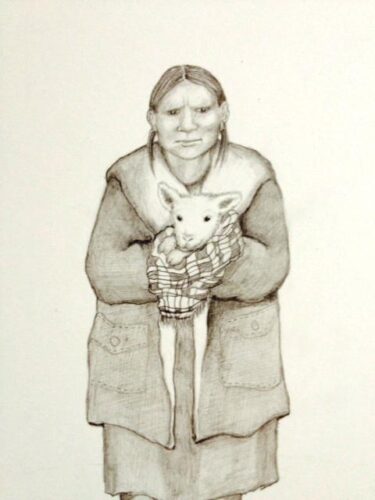 As with all her other books Erdrich does a E.L. Konigsburg and illustrates her own books (and she can even do horses – HORSES!). Her style is, as ever, reminiscent of Garth Williams’ with soft graphite pencil renderings of characters and scenes. These are spotted throughout the chapters regularly, and combined with the simplicity of the writing they make the book completely appropriate bedtime reading for younger ages. The map at the beginning is particularly keen since it not only highlights the locations in each part of the story but also hints at future storylines to come. Of these pictures the sole flaw is the book jacket. You see the cover of this book is a touch on the misleading side since at no point in this story does Makoons ever attempt to feed any baby bears (a terrible idea, namesake or no). Best to warn literal minded kids from the start that that scene is not happening. Then again, this appears to be a scene from the first book in the series, The Birchbark House, where Makoons’ mother Omakayas feeds baby bears as a girl. Not sure why they chose to put it on the cover this book but it at least explains where it came from.
As with all her other books Erdrich does a E.L. Konigsburg and illustrates her own books (and she can even do horses – HORSES!). Her style is, as ever, reminiscent of Garth Williams’ with soft graphite pencil renderings of characters and scenes. These are spotted throughout the chapters regularly, and combined with the simplicity of the writing they make the book completely appropriate bedtime reading for younger ages. The map at the beginning is particularly keen since it not only highlights the locations in each part of the story but also hints at future storylines to come. Of these pictures the sole flaw is the book jacket. You see the cover of this book is a touch on the misleading side since at no point in this story does Makoons ever attempt to feed any baby bears (a terrible idea, namesake or no). Best to warn literal minded kids from the start that that scene is not happening. Then again, this appears to be a scene from the first book in the series, The Birchbark House, where Makoons’ mother Omakayas feeds baby bears as a girl. Not sure why they chose to put it on the cover this book but it at least explains where it came from.
It is interesting that the name of this book is Makoons since Chickadee shares as much of the spotlight, if not a little more so, than his sickly brother. That said, it is Makoons who has the vision of the future, Makoons who offers the haunting prediction at the story’s start, and Makoons who stares darkly into an unknown void at the end, alone in the misery he knows is certain to come. Makoons is the Cassandra of this story, his predictions never believed until they are too late. And yet, this isn’t a sad or depressing book. The hope that emanates off the pages survives the buffalos’ sad departure, the sickness that takes two beloved characters, and the knowledge that the only thing this family can count on in the future is change. But they have each other and they are bound together tightly. Even Pinch, that trickster of previous books, is acquiring an odd wisdom and knowledge of his own that may serve the family well into the future. Folks often recommend these books as progressive alternatives to Laura Ingalls Wilder’s Little House books, but that’s doing them a disservice. Each one of these titles stands entirely on its own, in a world of its own making. This isn’t some sad copy of Wilder’s style but a wholly original series of its own making. The kid who starts down the road with this family is going to want to go with them until the end. Even if it takes another seventeen years. Even if they end up reading the last few books to their own children. Whatever it takes, we’re all in this together, readers, characters, and author. Godspeed, Louise Erdrich.
For ages 7-12
Source: Final copy sent from publisher for review.
Professional Reviews:
Other Blog Reviews: BookPage


By:
Betsy Bird,
on 8/5/2016
Blog:
A Fuse #8 Production
(
Login to Add to MyJacketFlap)
JacketFlap tags:
Best Books of 2016,
2016 picture books,
2016 reviews,
Reviews 2016,
2016 funny books,
2016 funny picture books,
Reviews,
picture books,
knitting,
funny books,
Roaring Brook,
Best Books,
macmillan,
funny picture books,
Vera Brosgol,
Add a tag
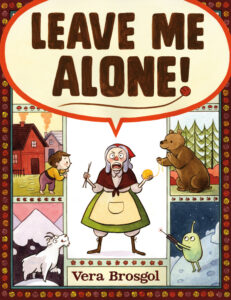 Leave Me Alone!
Leave Me Alone!
By Vera Brosgol
Roaring Brook Press (an imprint of Macmillan)
$17.99
ISBN: 9781626724419
Ages 4-7
On shelves September 13th
Knitting. It shouldn’t be so hard. I say this as the grown daughter of a chronic knitterer (not a word). I grew up neck deep in roving. I know the difference between a gossip wheel and a walking wheel (these are different spinning wheels). I know that if you want a permanent non-toxic dye for wool you use Kool-aid, that wool straight from the sheep is incredibly oily, and that out there are people who have turned the fur of their dogs and cats into sweaters. Yet the simplest act of knitting is lost on a good 50% of the children’s book illustrators out there that year after year can’t even be bothered to figure out which way the knitting needles are supposed to go. Down, people. The ends go down. In 2016 alone we’ve seen books like Maggie McGillicuddy’s Eye for Trouble get it wrong. Fortunately 2016 has also seen correctly positioned needles in Cat Knit, Ned the Knitting Pirate, and the greatest knitting related picture book I’ve seen to date Leave Me Alone! A superb readaloud of unparalleled visual humor, this is a knitting picture book par excellence and a pretty darn good original folktale too, come to think of it. Allowing for the occasional alien, of course.
“Once there was an old woman. She lived in a small village in a small house . . . with a very big family.” And by big family we mean big extended family. One gets the feeling that all her grown kids just sort of dump their own children on her, because there are thirty small grandchildren running amok in her home. Winter is coming soon and the old woman is keen on getting some knitting done for her extended brood. Trouble is, knitting and small children do NOT mix. So she picks up her stuff and goes into the deep, dark forest. That’s where the bear family finds her. So she goes to the mountains. Where the goats find her. Next it’s the moon. Where curious aliens find her. That leaves a wormhole where the void turns out to be her saving. Only problem is, it’s lonely in the void. Once her work is done, she heads back and when she sees her grandkids again, she doesn’t have to say a single word.
Here is the crazy thing about this book: It’s Vera Brosgol’s first picture book. I say that this is crazy because this does not read like a debut. This reads like Brosgol has been churning out picture books for decades, honing her skill, until finally at long last she’s produced a true diamond. But no. Some people get all the talent apparently. This is not, I should not, Ms. Brosgol’s first book in general. Her graphic novel Anya’s Ghost got a fair amount of attention a couple of years ago, and it was good. But nothing about that title prepared me for Leave Me Alone! Here we have a pitch perfect combination of text and image. If you were to read this book to someone without mentioning the creator, I don’t think there’s a soul alive who wouldn’t assume that the author and illustrator are one and the same. This is due largely to the timing. Just open the book to the first page. Examine the old woman on that page. Turn the page. Now look how that same woman has been transposed to a new setting and her expression has changed accordingly. Basically this sold the book to me right from the start.
 Funny picture books. For an author, creating a picture book that is funny means doing two things at once. You must appeal to both children and parents with your humor at the same time. Do you know how hard that is? Making something that a five-year-old thinks is funny that is also humorous to their parental unit is such a crazy balancing act that most picture book creators just fall on one side of the equation or the other. Make it funny only to adults and then you may as well just forget about the kids altogether (see: A Child’s First Book of Trump). Opt instead to only make it funny to kids and you doom the grown-ups to reading something they’d rather eat hot nails than read again (see: Walter the Farting Dog). But I honestly believe Brosgol has found the golden mean. Both adults and kids will find moments like the older sister stuffing a yarn ball in her brother’s mouth or the presence of the samovar (even in a wormhole) or the bear tentatively touching its nose after the old woman’s vigorous poke very funny indeed.
Funny picture books. For an author, creating a picture book that is funny means doing two things at once. You must appeal to both children and parents with your humor at the same time. Do you know how hard that is? Making something that a five-year-old thinks is funny that is also humorous to their parental unit is such a crazy balancing act that most picture book creators just fall on one side of the equation or the other. Make it funny only to adults and then you may as well just forget about the kids altogether (see: A Child’s First Book of Trump). Opt instead to only make it funny to kids and you doom the grown-ups to reading something they’d rather eat hot nails than read again (see: Walter the Farting Dog). But I honestly believe Brosgol has found the golden mean. Both adults and kids will find moments like the older sister stuffing a yarn ball in her brother’s mouth or the presence of the samovar (even in a wormhole) or the bear tentatively touching its nose after the old woman’s vigorous poke very funny indeed.
And let’s not downplay the writing here. There is serious readaloud potential with this book. I’ll level with you. In a given year you’ll see hundreds and hundreds of picture books published. Of these, a handful make for ideal readalouds. I’m not talking about books a parent can read to a child. I’m talking about books you can read to large groups, whether you’re a teacher, a librarian, or some poor parental schmuck who got roped into reading aloud to a group of fidgeting small fry. Few books are so good that anyone and everyone can enrapture an audience with them when read out loud. But Leave Me Alone! may be one of those rare few. Those beautiful butterflies. Those little jewels. The language mimics that of classic folktales, bandying about phrases like, “deep, dark forest”. And there are so many interactive possibilities. You could teach the kids how to yell out the phrase “Leave me alone!” all together at the same time, for example.
 As for the art, it’s perfect. There’s a kind of Kate Beaton feel to it (particularly when babies or goats have full balls of yarn stuffed into their mouths). As I mentioned before, Brosgol knows which way knitting needles are supposed to lie, and better still she knows how to illustrate thirty different, and very realistically rendered sweaters, at the story’s end. There are also some clever moments that you’ll notice on a third or fourth read. For example, the very first time the woman yells, “Leave me alone!” she’s exiting the gates to her home and her children’s homes. The only people who hear her are her grown children, which means we don’t have to worry about small ears hearing such a caustic phrase from their grandma. Smart. And did you see that the twins get identical sweaters at the end of the book? Finally, there are the visual gags. The goats that surreptitiously followed the old woman to the moon, nibbling on a moon man’s scanner, for example.
As for the art, it’s perfect. There’s a kind of Kate Beaton feel to it (particularly when babies or goats have full balls of yarn stuffed into their mouths). As I mentioned before, Brosgol knows which way knitting needles are supposed to lie, and better still she knows how to illustrate thirty different, and very realistically rendered sweaters, at the story’s end. There are also some clever moments that you’ll notice on a third or fourth read. For example, the very first time the woman yells, “Leave me alone!” she’s exiting the gates to her home and her children’s homes. The only people who hear her are her grown children, which means we don’t have to worry about small ears hearing such a caustic phrase from their grandma. Smart. And did you see that the twins get identical sweaters at the end of the book? Finally, there are the visual gags. The goats that surreptitiously followed the old woman to the moon, nibbling on a moon man’s scanner, for example.
I’ve seen a fair amount of hand wringing over the years over whether or not a children’s book can contain a protagonist that is not, in fact, a child, an animal, or an inanimate object rendered animate. Which is to say, are children capable of identifying with adults? More precisely, an adult who just wants to be alone for two seconds? The answer is swift and sure. Certainly they can. Particularly if the kid reading this book is an older sibling. The concept of being alone, of craving some time for one’s own self, is both familiar and foreign to a lot of kids. I’m reminded of the Frog & Toad story “Alone” from Days With Frog and Toad where Toad has a dark morning of the soul when he learns that Frog would like to have some alone time. Because of all of this, we see a lot of picture books where a character wants to be alone, has difficulty getting that “me time”, and eventually decides that companionship is the way to go (Octopus Alone, A Visitor for Bear, etc.). A few celebrate the idea (All Alone] by Kevin Henkes) but generally speaking parents use these books to convince their perhaps less than socially adept children that there are benefits to the concept of friendship. And there is a place in the world for such books. Fortunately there is also a place in the world for this book.
Folks sometimes talk to me about current trends in picture books. Sometimes they’re trying to figure out what the “next big thing” might be. But of course, the best picture books are the ones that at their core don’t really resemble anything but themselves. Leave Me Alone! isn’t typical. It reads aloud to big crowds of kids with great ease, lends itself to wonderful expressions, pops off the page, and will make anyone of any age laugh at some point. It’s a great book, and if I have to write another 500 words to convince you of it, I can do so. But why delay you from seeing it any longer? Go. Seek. Find. Read. Savor.
On shelves September 13th.
Like This? Then Try:
Source: Galley sent by publisher for review.
Misc: Cute promotion or THE CUTEST PROMOTION? As you can see from this Bustle interview, Ms. Brosgol knit twenty-five teeny tiny sweaters to promote this book. I steal the image for my own nefarious purposes and show it to you here:



By:
Betsy Bird,
on 7/21/2016
Blog:
A Fuse #8 Production
(
Login to Add to MyJacketFlap)
JacketFlap tags:
Reviews,
middle grade fantasy,
funny books,
Best Books,
abrams,
Amulet Books,
Amy Ignatow,
middle school novels,
middle school fantasy,
funny fantasy,
Best Books of 2016,
Reviews 2016,
2016 middle grade fantasy,
2016 middle grade fiction,
2016 funny books,
2016 middle school fiction,
Add a tag
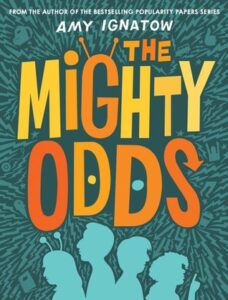 The Mighty Odds
The Mighty Odds
By Amy Ignatow
Amulet Books (an imprint of Abrams)
$15.95
ISBN: 978-1-4197-1271-5
Ages 10 and up
On shelves September 13th
If you could have one weird superpower, what would it be? Not a normal one, mind you. We’re not doing a flight vs. invisibility discussion here. The power would have to be extraordinary and odd. If it’s completely useless, all the better. Me? I think I’d like my voice to be same as the voice you hear in your head when you’re reading something. You know that voice? That would be my superpower. A good author can crank this concept up to eleven if they want to. Enter, Amy Ignatow. She is one of the rare authors capable of making me laugh out loud at the back covers of her books. For years she’s penned The Popularity Papers to great success and acclaim. Now that very realistic school focus is getting a bit of a sci-fi/fantasy kick in the pants. In The Mighty Odds, Ignatow takes the old misfits-join-together-to-save-the-world concept and throws in a lot of complex discussions of race, middle school politics, bullying, and good old-fashioned invisible men. The end result is a 21st century superhero story for kids that’s keeps you guessing every step of the way.
A school bus crashes in a field. No! Don’t worry! No one is killed (that we can tell). And the bus was just full of a bunch of disparate kids without any particular connection to one another. There was the substitute teacher and the bus driver (who has disappeared). And there was mean girl Cookie (the only black girl in school and one of the most popular), Farshad (nicknamed “Terror Boy” long ago by Cookie), Nick (nerdy and sweet), and Martina (the girl no one notices, though she’s always drawing in her sketchbook). After the accident everything should have just gotten back to normal. Trouble is, it didn’t. Each person who was on or near the bus when the accident occurred is a little bit different. It might be a small thing, like the fact that Martina’s eyes keep changing color. It might be a weird thing, like how Cookie can read people’s minds when they’re thinking of directions. It might be a powerful thing, like Farad’s super strength in his thumbs. Or it might be a potentially powerful, currently weird thing like Nick’s sudden ability to teleport four inches to his left. And that’s before they discover that someone is after them. Someone who means them harm.
Superhero misfits are necessarily new. Remember Mystery Men? This book reminded me a lot of that old comic book series / feature film. In both cases superpowers are less a metaphor and more a vehicle for hilarity. I read a lot of books for kids but only once in a while do I find one enjoyable enough to sneak additional reads of on the sly. This book hooked me fairly early on, and I credit its sense of humor for that. Here’s a good example of it. Early in the book Cookie and a friend are caught leaving the field trip for their own little side adventure. The kids in their class speculate what they got up to and one says that clearly they got drunk. Farshad’s dry wit then says, “… because two twelve-year-olds finding a bar in Philadelphia that would serve them at eleven A.M. was completely plausible.” Add in the fact that they go to “Deborah Read Middle School” (you’ll have to look it up) and I’m good to go.
Like I’ve said, the book could have just been another fun, bloodless superhero misfit storyline. But Ignatow likes challenges. When she wrote the Popularity Papers books she gave one of her two heroines two dads and then filled the pages with cursive handwriting. Here, her heroes are a variety of different races and backgrounds, but this isn’t a Benetton ad. People don’t get along. Cookie’s the only black kid in her school and she’s been very careful to cement herself as popular from the start. When her mom moved them to Muellersville, Cookie had to be careful to find a way to become “the most popular and powerful person in school.” Martina suggests at one point that she likes being angry, and indeed when the world starts to go crazy on her the thing that grounds her, if only for a moment, is anger. And why shouldn’t she be angry? Her mom moved her away from her extended family to a town where she knew no one, and then her mother married a guy with two kids fairly fast. Cookie herself speculates about the fact that she probably has more in common with Farshad than she’d admit. “He was the Arab Kid, just like Cookie was the Black Girl and Harshita Singh was the Indian Girl and Danny Valdez was the Hispanic Guy and Emma Lee was the Asian Chick. They should have all formed a posse long ago and walked around Muellersville together, just to freak people out.” Cookie realizes that she and Farshad need to have one another’s backs. “It was one thing to be a brown person in Muellersville and another to be a brown person in Muellersville with superpowers.” At this point in time Ignatow doesn’t dig any deeper into this, but Cookie’s history, intentions, and growth give her a depth you won’t find in the usual popular girl narrative.
For the record, I have a real appreciation for contemporary books that feature characters that get almost zero representation in books. For example, one of the many things I love about Tom Angleberger’s The Qwikpick Papers series is that one of the three heroes is Jehovah’s Witness. In this book, one of the kids that comes to join our heroes is Amish. Amish kids are out there. They exist. And they almost never EVER get heroic roles in stories about a group of friends. And Abe doesn’t have a large role in this book, it’s true, but it’s coming.
Having just one African-American in the school means that you’re going to have ignorant other characters. Cookie has done a good job at getting the popular kids in line, but that doesn’t mean that everyone is suddenly enlightened. Anyone can be tone deaf. Even one of our heroes, which in this case means Nick’s best friend, the somewhat ADD, always chipper Jay. Now I’ve an odd bit of affection for Jay, and not just because in his endless optimism he honestly thinks he’ll get permission to show his class Evil Dead Two on the field trip bus (this may also mark the first time an Evil Dead film has been name dropped in a middle grade novel, by the way). The trouble comes when he talks about Cookie. He has a tendency to not just be tone deaf but veering into really racially questionable territory when he praises her. Imagine a somewhat racist Pepe Le Pew. That’s Jay. He’s a small town kid who’s only known a single solitary black person his entire life and he’s enamored with her. Still, that’s no excuse for calling her “my gorgeous Nubian queen” or saying someday they’ll “make coffee-colored babies.” I expected a little more a comeuppance for Jay and his comments, but I suppose that’ll have to wait for a future book in the series. At the very least, his words are sure to raise more than few eyebrows from readers.
Funny is good. Great even. But funny doesn’t lift a middle grade book out of the morass of other middle grade books that are clogging up the bookstores and libraries of the world. To hit home you need to work just a smidgen of heart in there. A dose of reality. Farad’s plight as the victim of anti-Muslim sentiment is very real, but it’s also Nick’s experiences with his dying/dead father that do some heavy lifting. As you get to know Nick, Ignatow sprinkles hints about his life throughout the text in a seamless manner. Like when Nick is thinking about weird days in his life and flashes back to the day after his dad’s funeral. He and his mom had “spent the entire day flopped on the couch, watching an impromptu movie marathon of random films (The Lord of the Rings, They Live, Some Like It Hot, Ghostbusters, and Babe) and eating fancy stuff from the gift baskets that people had sent, before finally getting up to order pizza.” There’s a strong smack of reality in that bit, and there are more like it in the book. A funny book that sucker punches your heart from time to time makes for good reading.
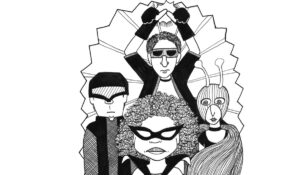 Lest we forget, this is an illustrated novel. Ignatow makes the somewhat gutsy choice of not explaining the art for a long time. Long before we even get to know Martina, we see her in various panels and spreads as an alien. In time, we learn that the art in this book is all her art, and that she draws herself as a Martian because that’s what her sister calls her. Not that you’ll know any of this for about 125 pages. The author makes you work to get at that little nugget of knowledge. By the way, as a character, Martina the artist is fascinating. She’s sort of the Luna Lovegood of the story. Or, as Nick puts it, “She had a sort of almost absentminded way of saying things that shouldn’t have been true but probably were.” There is one tiny flub in the art when Martina draws all the kids as superheroes and highlights Farshad’s thumbs, though at that point in the storyline Martina wouldn’t know that those are his secret weapons. Other than that, it’s pretty perfect.
Lest we forget, this is an illustrated novel. Ignatow makes the somewhat gutsy choice of not explaining the art for a long time. Long before we even get to know Martina, we see her in various panels and spreads as an alien. In time, we learn that the art in this book is all her art, and that she draws herself as a Martian because that’s what her sister calls her. Not that you’ll know any of this for about 125 pages. The author makes you work to get at that little nugget of knowledge. By the way, as a character, Martina the artist is fascinating. She’s sort of the Luna Lovegood of the story. Or, as Nick puts it, “She had a sort of almost absentminded way of saying things that shouldn’t have been true but probably were.” There is one tiny flub in the art when Martina draws all the kids as superheroes and highlights Farshad’s thumbs, though at that point in the storyline Martina wouldn’t know that those are his secret weapons. Other than that, it’s pretty perfect.
It’s also pretty clearly middle school fare, if based on language alone. You’ve got kids leaving messages on cinderblocks that read “Nolite te bastardes carborundorum” or “Don’t let the bastards get you down.” That may be the most realistic middle school detail I’ve read in a book in a long time. The bullying is systematic, realistic, and destructive (though that’s never clear to the people doing the bullying). A little more hard core than what an elementary school book might discuss. And Cookie is a superb bully. She’s honestly baffled when Farad confronts her about what she’s done to him with her rumors.
A word of warning to the wise: This is clearly the first book in a longer series. When you end this tale you will know the characters and know their powers but you still won’t know who the bad guys are exactly, why the kids got their powers (though the bus driver does drop one clue), or where the series is going next. For a story where not a lot of time passes, it really works the plotting and strong characterizations in there. I like middle grade books that dream big and shoot for the moon. “The Mighty Odds” does precisely that and also works in some other issues along the way. Just to show that it can. Great, fun, silly, fantastical fantasy work. A little smarter and a little weirder than most of the books out there today.
On shelves September 13th.
Source: Galley sent from publisher for review.
Readalikes:
Professional Reviews:

 Every single list that appears on this blog is subjective. I mean, here I am declaring stuff to be great based entirely on a single solitary opinion: my own. That’s okay when you’re talking alphabet books or readalouds, but humor is a far trickier matter. There are a LOT of humorous picture books that come out in a single year and this list is just a miniscule smattering of the whole. That said, these are the books that really retained a strong grip on my brain after reading them. There were other funny books out in 2016. I’m just particularly partial to the following. I’m pleased with the number of funny women representing here too. After all, if there’s one thing I know something about, it’s funny girls.
Every single list that appears on this blog is subjective. I mean, here I am declaring stuff to be great based entirely on a single solitary opinion: my own. That’s okay when you’re talking alphabet books or readalouds, but humor is a far trickier matter. There are a LOT of humorous picture books that come out in a single year and this list is just a miniscule smattering of the whole. That said, these are the books that really retained a strong grip on my brain after reading them. There were other funny books out in 2016. I’m just particularly partial to the following. I’m pleased with the number of funny women representing here too. After all, if there’s one thing I know something about, it’s funny girls.

































Yahoopy! I adore Best Frints in the Whole Universe and so do my 6-year-old and 3-year-old boys.
Fun thing to do: read a kid the book and then ask them whether Yelfred and Omek are boys or girls. I love that the book never lets on one way or another.
Thank you so much for these lists! It’s making every morning extra special!
The tree frog gag is hilarious. Thank you for that. And for everything else.
Love the lists! Thank you.
Thanks for all the great recs! I loved A Hungry Lion & Leave Me Alone. Very curious about Next to You, since it doesn’t have a typical funny-looking cover.
That’s part of its allure.
If my 2-year-old was picking the best book of the year it would be Poor Little Guy. It’s his favorite book and he keeps requesting it from the library. He loves it and he thinks it’s so funny. One of my favorites of the year too.
I’m also so glad to see someone else you loves Super Happy Magic Forest. So much for fantasy fans and geeky parents and their kids. I love all the many various side comments and speech bubbles. It has so much going on it’s a delight to read!
How did you know I needed a laugh? Thanks for this list and inspiring me to write a funny book of my own!